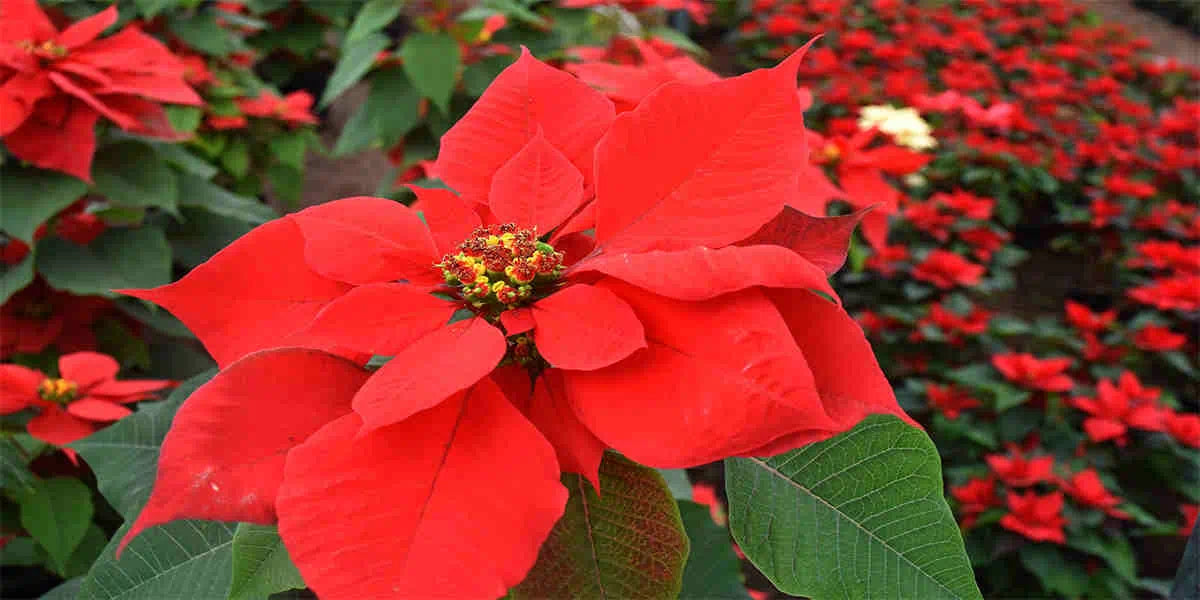Flowers can represent many things, love, gratitude, mourning, etc. It is also a must for many occasions and a gift-giving choice that can never go wrong. No one hates receiving flowers, especially on a birthday.
Each month has its representative flower bloom, which is like the birth of life. So, there are also birth flowers for the month of birth. These 12 types of flowers represent different messages, the spirit that leads people upward, or love, or affection and friendship. It also contains the good wishes of people for life.
If you are wondering what is my birth flower? And what is the meaning of the flower? We have compiled information about the monthly birth flowers, come and find yours!

(Birth flower)
January Birth Flower: Carnation
January's birth flower is the carnation, which has fan-shaped petals and flowers with mostly crinkled inner petals. Colors include red, pink, yellow, and white. Carnations include many variants and hybrids and can bloom almost continuously in a greenhouse.
Carnations represent passion, charm, motherly love, blessing, affection, greatness, etc.
However, carnations come in a variety of colors. Different colors of carnations can represent slightly different meanings. For example, white carnations represent pure,true love, and respect. Pink carnations represent beauty and motherly love. Red carnations represent adoration and passion. Yellow carnations are very different, representing disappointment, and rejection.

(Carnation)
How to grow carnations
Carnations should be grown in well-drained, fertile soil with good permeability. It requires full light in winter and cool conditions in the summer heat. Carnations can be sown or cut, depending on the temperature of the location. Sow seeds and cover them with a shallow layer of soil, then moisten them with a sprinkler afterward. It will germinate within a week.
In the case of cuttings, choose fresh, strong branches with many side shoots. Insert two inches into the soil, paying attention to the direction of the cuttings, and keeping the leaves facing upwards. Just water the cuttings afterward. During the spring and fall, when carnations are growing, it is best to keep the soil slightly moist for a long time to facilitate their growth. Keep the soil slightly dry in the summer when it is hot and in the winter when it is cold.
February Birth Flower: Violet
February's birth flower violets have very small petals. The color is purple, light red, or white, with fragrant, showy characteristics.
The flower language of violets is eternal beauty and love, simplicity and virtue. And the meaning of the different colors of violets varies. Purple violets represent vigilance, loyalty, and love. The white violet represents happiness and purity.

(Violet)
How to grow violet
Violets are not too strict on soil requirements and are easy to transplant. They are usually propagated from seed. Place the seeds in moist soil, preferably 8 to 12 inches apart. Cover with a fine layer of soil and place in a cool place. Water the seedlings well during the seedling stage. Water every other day to keep the soil moist. But be sure to avoid water logging, if the water is watered too much to drain in time.
Apply a liquid fertilizer every 10 days during the seedling stage. However, the amount should not be too much, which will help the growth to flourish without hurting the rootstock. After sowing the seeds, they will germinate in about two weeks.
March Birth Flower: Daffodil
Daffodils, as the March birth flower, are mostly white and yellow. The petals are mostly 6 and yellow at the end of the petals. But, its bulbs are poisonous to animals, so it is best to avoid planting them if you have pets at home.
Daffodils are rich in symbolic meaning, being a symbol of friendship, happiness, and good fortune, and are also regarded as a symbol of beauty, purity, and nobility. Daffodils are also the first flowers to bloom in spring, so they also represent beginnings and rebirth.

(Daffodil)
How to grow daffodils
There are two types of cultivation for daffodils, one is hydroponics and the other is soil cultivation. The hydroponics method means cultivation in shallow pots by water immersion. The germinated daffodils are placed upright in a pot, and water is added to submerge one-third of the stem. The bulbs can be fixed with quartz sand or pebbles in the pot. Place in a sunny area during the day.
Move them indoors at night and pour out the water in the pots. Add water the next morning, taking care not to move in the direction of the bulbs. During the seedling period, you can change the water once a day, and then every 2 to 3 days. After the flower buds are formed, change the water once a week and the flowers will bloom in about 45 days.
Soil culture involves planting the bulbs with the tips facing upward in the soil about 6 inches deep. Regular watering is required in the spring and fall, while daffodils go dormant during the summer months.
April Birth Flower: Daisy
This bright flower is a good representation of the April birth flower. Although it may not be as showy in appearance as other flowers, it will still make a splash. Daisies come in white, pink, and red.
White daisy meanings include new beginnings, hope, and innocence. Yellow daisies represent friendship, joy, happiness, and good wishes. Pink daisies symbolize affection and love.

(Daisy)
How to grow daisies
Daisy planting requires the selection of well-drained sandy soil for seedlings. First, cover the seeds with a thin layer of soil after sowing. Flowering occurs 12-14 weeks after sowing. Watering about once or twice a week is sufficient to meet the growth needs. When the temperature gets warmer in summer, it is necessary to water every day at this time. Meanwhile, Daisy likes warm but not strong sunlight. It will grow better in late summer and early fall.
May Birth Flower: Lily of the Valley
The lily of the valley, the birth flower of May, is creamy white and has broad bell-shaped, pendulous flowers. The lily of the valley bears fruit and the fruiting period is from July to September. Although this flower is very beautiful, the whole plant contains toxicity and should be avoided by pets.
The lily of the valley is a symbol of purity, happiness, and joy, and is used in many countries for weddings.

(Lily of the valley)
How to grow lily of the valley
Lily of the Valley likes a shady environment and is more suitable for growing in pots. It requires loose, airy, and fertile soil with good drainage. It is most convenient to plant directly on the rootstock, followed by a thin layer of soil and spaced 6 inches apart.
Every 15 days, the lily of the valley should be fertilized. It is less drought tolerant and it prefers a moist environment. You should often spray some water around the potted plant properly, to increase the humidity of the air.
June Birth Flower: Rose
June's birth flower, the rose, is one of the most famous and popular categories of all flowers. Roses are available in white and yellow, pink to red colors. And the different colors of roses represent different symbols.
For example, red roses represent romantic love, passion and are the most popular flower for Valentine's Day.
Yellow roses represent friendship and joy. Pink roses mean young and innocent love and can also represent admiration. White roses represent purity, innocence, and elegance and are also perfect for weddings.

(Pink rose)
How to grow roses
Roses like full sun, are cold and drought tolerant. Prefers well-drained, loose, and fertile loamy soil. First place the soaked seeds in the soil, placing 5-7 seeds in each container. After the seeds have germinated, leave a stronger plant depending on the growth of the seedlings. After germination, interplant, leaving 1 to 3 seedlings as appropriate.
After sowing, cover the top of the container with plastic wrap and prick several small holes in it for ventilation. Generally speaking, the seedlings will germinate in about a week, and after germination, wait for the seedlings to grow strong and transplant them into the ground. After that, it needs to be watered every week.
July Birth Flower: Larkspur
Larkspur is a species with several flowers on one plant and has a very bushy appearance. It is also very colorful, with purple, pink, blue, and white. Larkspur, in blue, represents elegance and hesitation. Purple represents first love. Pink stands for freshness. White represents joy.

(Larkspur)
How to grow larkspur
The larkspur is a common garden flower and is also extremely easy to grow. It prefers cool and light growing conditions and is hardy. So the best season to grow it is in spring and autumn, or late summer. Larkspur is easy to grow even from seed. It needs to be fertilized every two weeks during the summer to ensure strong growth.
During the flowering period, it is necessary to water properly and keep the soil moist to prolong the flowering period. It is also important to note that larkspur is also toxic make sure your pets stay away from this flower.
August Birth Flower: Gladiolus
Gladiolus has tall flower spikes with erect, unbranched flower stems. The flowers are solitary in the bract, symmetrical on both sides, and come in red, yellow, white, or pink. Gladiolus usually represents elegance, loyalty, and tranquility. It is also considered the flower of gladiolus because of its tall, upright appearance. Its flowers are colorful, long-lasting, and extremely decorative.

(Gladiolus)
How to grow gladiolus
Gladiolus likes warmth and full sun and grows best in fertile, slightly acidic sandy soil. First, sterilize the gladiolus seed ball for half an hour and then bury it in the soil about 5 inches deep. After that, cover it with soil. After watering the plant once, place it in a warm and airy place and keep it in a moist environment, and the gladiolus will germinate soon.
When the stems start to grow, watering should be increased to keep the soil moist. It will bloom in about two months under the right temperature environment. This is a perennial plant that can grow steadily with proper care.
September Birth Flower: Aster
The September birth flower aster has smaller flowers, mostly blue or purple, with occasional white and rose. It is a very vigorous flower and is used for decoration. Aster represents liveliness, enthusiasm, and courage.

(Aster)
How to grow aster
The aster is hardy and also tolerates drought and heat, and is highly adaptable. Seeds can be sown directly into the soil, taking care to space each one three inches apart. Then cover the soil with water. After sowing the seeds, it is important to control the temperature.
Especially just after sowing, the temperature should not be lower than 60 °F to affect the normal germination of the seeds, which usually a week to emerge. Aster has strict requirements for moisture, neither waterlogged nor too dry. It should be watered once every 7-10 days, and the soil should be kept moist frequently. It can also be pruned to promote dense flowers.
October Birth Flower: Marigold
Marigolds have slightly larger flowers and are mostly yellow. And this golden-yellow flower, as the October birth flower, can serve as a bright accent for autumn. What's even more special is that the leaves and petals of the marigold are edible and have a special fragrance. The meaning of the marigold varies from place to place, from warmth and enthusiasm. It also has a parting, sad meaning.

(Marigold)
How to grow marigolds
Marigolds like to grow in mild, cool climates. It is afraid of heat and cold and requires a light environment. Suitable for loose, well-drained, fertile soil. The best time to sow is autumn and early spring when it will germinate a week after sowing and flower within 8 weeks.
During the growth of marigolds should keep the soil moist. Choose to water at night or early in the morning when the temperature is cooler and keep the leaves dry at night. In winter, watering intervals need to be longer and should be done at midday on sunny days when the temperature is higher.
November Birth Flower: Chrysanthemum
This is a flower with deep cultural significance, first cultivated in China, and one of the four most common plants in traditional paintings. Chrysanthemums come in many varieties and colors, including purple, red, pink, and orange, besides the most common yellow. The typical meaning of chrysanthemum is purity, nobility, longevity, and health.

(Chrysanthemum)
How to grow chrysanthemums
Chrysanthemum is a short-sun plant, which can bloom early under short sunlight. It prefers sunlight, is more drought tolerant, and is afraid of waterlogging. It is a hardy perennial and can be planted in early spring.
During the seedling period, watering should be sparing. And when the weather is hot and evaporation is high, watering should be sufficient. Before flowering, watering should be increased and fertilization should be started. Fertilization can be stopped after flower buds appear again. In winter, the flowering branches stop growing and the water consumption of the plant is significantly reduced, so watering must be controlled.
December Birth Flower: Poinsettia
Poinsettia has bright colors and a long flowering period, opening around December. It is usually used for Christmas decorations and is the most appropriate December birthday flower. People are easily attracted by its bright red appearance. But it is the foliage that is bright red, the real flowers are tiny and light. Hidden in these red leaves disguised as flowers, the flowers are yellowish-green and are not easy to spot. Poinsettia means blessing, success, and luck.

(Poinsettia)
How to grow poinsettia
Poinsettia prefers a warm and humid climate, is not cold tolerant, and is more afraid of frost. It does not tolerate drought or flooding. Poinsettia is best propagated using plugs. Poinsettia is best propagated by inserting branches into the soil after they have been slightly soaked in a disinfectant solution and then dried out a bit. Afterward, the soil is compacted and a layer of fine sand is sprinkled on the pot's surface and watered sufficiently.
Since the plant does not tolerate watering, it is essential to consider the air humidity and weather conditions of the last few days when watering. It is best if the soil is moist but not waterlogged.
Conclusion
“A flower’s appeal is in its contradictions — so delicate in form yet strong in fragrance, so small in size yet big in beauty, so short in life yet long on effect.”– Terri Guillemets
Flowers can bring not only visual enjoyment but also spiritual solace. Regardless of gender, flowers always make people feel unique, especially birth flowers. This will make the person receiving the flowers feel valued and cherished. Learn about the monthly birth flowers that will make a difference on your or someone's next birthday.
(Quictent portable greenhouse)
Quictent's portable greenhouse and raised garden beds can provide you with the perfect growing environment for flowers to flourish. Come pick up the perfect gardening product for your plant's growing period!








